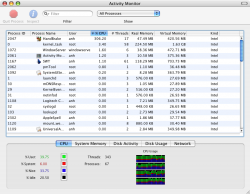Very nice.
I can't decide whether I like Handbrake or Mac the Ripper better. I've kind of been using them both.
I always, always use them both together.
First, Mac The Ripper is better at reading the contents of DVDs. There are quite a few DVDs out there with nasty copy protection that Handbrake cannot read.
But more important to me, using Mac The Ripper puts much less strain on the DVD drive. If you rip a movie to H.264, in best quality with 2-pass encoding, it takes about 2 1/2 hours on a MacBook for every hour of movie. And your DVD drive is running all the time. With Mac The Ripper, the time reading the DVD is much much shorter.
The other thing is, using Mac The Ripper I can let Handbrake rip several DVDs overnight. I use Mac The Ripper to copy three or four DVDs onto the harddisk, then start Handbrake and it rips overnight (and usually the next day while I'm at work). Can't do that without Mac The Ripper because you would have to swap DVDs.


 tv, yes? I don't really care about watching movies on my iMac or iPod anymore.
tv, yes? I don't really care about watching movies on my iMac or iPod anymore. 